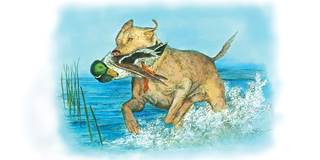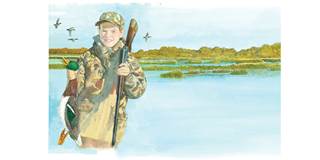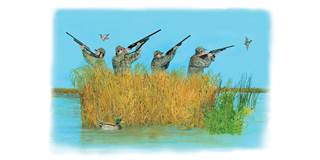A Perfect Season
A good waterfowl season features plenty of birds in the bag. A perfect season leaves you with memories that last a lifetime
A good waterfowl season features plenty of birds in the bag. A perfect season leaves you with memories that last a lifetime
By Doug Larsen, Illustrations by John Foster Dyess
If you have hunted waterfowl for any length of time, at some point you have finished a season and thought, Next year will be better. Even after a good season, I always think of something that could have gone bettera hunt when the predicted snow turned out to be rain, or a hunt when the ducks just didn't get the memo. Sometimes you take a couple days off from work and find that the ducks have already pushed through. It almost never fails that, when you invite a guest or fill up the blind with friends, the day turns out to be less than expected. Murphy's Law often applies to duck hunts too.
Many of us start hunting in the warmth of early fall and continue through early winter. A lot can happen during that time. Changes in weather and migrations can be pronounced, hunting pressure comes and goes, water freezes and melts, zones open and close. But every once in a while, it all comes together and stays together for a whole seasonthe elusive perfect season.
The closest I came to a perfect season was in 2007. It was only 13 years ago, but it was a much different time, and now it feels like long ago. The iPhone made its debut in 2007. Folks stood in line for days to get one. The last book in the Harry Potter series was released. Britney Spears shaved her head. Bob Barker quit The Price Is Right.
That season was exceptional for a number of reasons. Pop culture aside, it was a better-than-average year for waterfowlers. Ducks were abundant, and liberal seasons and bag limits remained in place. I had a job that blessed me with a high degree of flexibility. In duck hunting, flexibility equals opportunity, and opportunity contributes to success. Looking back on things, my great hunting likely had less to do with waterfowl numbers and more to do with what I did to fit together the pieces of my own duck puzzle across an entire season.
I had access to some really good duck ground that year, and that ground was just coming off being very, very dry. So when water covered it again in summer and fall, seed-producing moist-soil plants exploded. What had been a semiproductive hole was now a duck buffet. Starting with the early teal season, I could see that the ducks were going to use that real estate.

In addition to the habitat being right, my dog Mack had come into his own. He was four, and for him it was the sweet spot in his hunting life. He was fully trained and obedient but still had a young dog's exuberance. Picking up ducks was exciting for him, but it was no longer new. He knew his job, and I didn't worry about him doing his job.
Finally, and best of all, that was the year my son, Riley, started duck hunting seriously. It was the season when I was able to begin building a new duck hunter from scratch. I was blessed with two important ingredients required for this taskan enthusiastic eight-year-old and abundant ducks. A major factor in the excellent quality of that season was my opportunity to experience the joys of discovering waterfowling through his eyes.
I recall a typical morning from that glorious season. In my log I recorded "light winds from the southwest and partial clouds." Friends and I had enjoyed great hunting in the same spot on opening weekend, and then I let the place sit for the balance of the week. The following Saturday, my son and I were in our blind early. I remember thinking that it was likely to be a good morning, but the weather was not going to be conducive to staying out for long. We would most likely have some opportunities in the first hour, so we prepared to do business early.
At shooting time there were not many ducks moving, but I heard volleys in the distance. They were not typical early-season volleys, which are usually a shot or two at a single wood duck, or one shot at a decoying mallard. No, these were substantial volleysthree shots from three guns in rapid succession. About the time I wondered what was happening, 25 or 30 green-winged teal tore into the decoy spread and landed. Five or six were swimming just off the blind and the others were scattered throughout the decoys. I quickly hatched a plan for Riley to get a shot as they jumped. He managed to drop a drake while I downed two others.

Mack had just delivered the last of the little ducks and was still shaking the water off when another flock of teal rolled out over the decoys. My son didn't fare as well on this group, but I added another bird to the pile. This pattern lasted for nearly an hour. Clearly a teal migration had arrived in the area. The diminutive speedsters were everywhere.
Later in the morning a single mallard visited the spread. Riley stayed cool and collected and took his first mallard with one shot. To commemorate the event, I waded him out into the decoys and dug a camera out of my bag. The proud hunter stood grinning in the morning sun with a mallard in one hand and a shotgun in the other. As the shutter clicked, a dozen greenwings photo-bombed the scene. I still have that photo pinned to the wall in my officesmiling youngster in the foreground, teal racing past just behind. I couldn't duplicate that photo if I hunted another 40 years. The following week he shot his first goose in that same hole.
Eventually the weather, of course, and those teal passed through. But as the season marched along the big ducks filled the void. On one midweek day when we knew the weather was going to be right for a mallard hunt, four of us gathered in the marsh. We enjoyed a hunt on a cold morning with a true-blue norther passing through. It was that rare day when every detail was precisely right. I have been on many hunts where we got limits faster, or the duck hole was more beautiful, but that day the exact right people were in the exact right place with bright sun and high ducks breaking to our calls.
Skim ice formed around the two-acre hole, and two separate groups of gadwalls came just after shooting light. Unlike the skittish gadwalls we often encounterducks that hang just out of range and refuse to decoy despite our best effortsthese groups sailed right into our spread. Nine ducks fell, all four from the first group and all five from the second.
While it was a very exciting start to the morning, the most interesting thing to me was that these ducks decoyed so well. They hung in the breeze and were spread across the decoys in ideal fashion. Mack and another dog divided the retrieving and got along famously as they split the workload.
The gadwalls worked perfectly, and later the mallards did as well. Over the next several hours, mallards came in small groups, twos and threes and fours, spiraling from on high to decoy in classic fashion. We took turns shooting, we made fried bologna sandwiches over a small camp stove, and we laughed and joked and shot ducks. When it was over, we all stood in the blind for a long time. None of us wanted to leave. Collectively we wished that we could have frozen time and stayed there making sandwiches and working drake mallards forever.

Once the weather pulled the curtain down for us at home, I was fortunate enough to get a call from friends in Arkansas, and in December Riley and I made the drive to a small camp in rice country. Traveling with a youngster, I knew I couldn't just roll into camp without making a couple stops along the way. I thought he would enjoy being a hunting tourist, and I snapped a photo of him with his cap down tight, standing in front of the giant mallard at Mack's Prairie Wings in Stuttgart.
We nosed around town for a time, then stopped at field after field to watch and photograph snow and white-fronted geese. In my mind I still see the image of my boy with his nose pressed against the truck window as hundreds upon hundreds of geese swirled noisily above us.
Riley had been quite comfortable hunting at home, where we could accommodate his smaller stature. But hunting from a deep pit in a rice field was a challenge. Birds were plentiful in Arkansas that year, and the hunting for mallards, pintails, and specks was outstanding. Full straps were the norm as big ducks and whitefronts hit the rice fields. In spite of this, my son struggled. If you have ever hunted from a pit, you know it is a delicate dance to get birds in range and then quickly roll back a pit top or throw back a pit flap before quickly picking out a bird and shooting. Everything has to happen in one smooth motion. Part of the problem was that Riley was just too short to fully clear the pit top when the action happened. We solved that by bringing a couple of plastic crates for him to stand on.
The mallards and pintails from those days in the rice should have been what we most remembered. Shovelers also filled the fields, but those were birds we generally ignored. However, when you are eight, you just can't stand to let ducksany ducksfly over the decoys all morning unscathed. Late one morning, we told our young blind mate that if he wanted to give the next bunch of shovelers a go, he was welcome to. He stood on his crates, pulled one of the flaps over his head, and waited. Soon a squad of spoonbills peeled over the levee. As they flared over the pit a shotgun barrel poked out from under the pit flap, and with one shot from a 20-gauge, two shovelers fell stone dead out of the blue Grand Prairie sky. If there were a way to measure happiness in a young boy, that young duck hunter would have broken the gauge. As a pit full of salty old waterfowlers cheered and clapped, I could hardly have been happier myself.
The perfect end to a nearly perfect season? You couldn't have written it any better.
Ducks Unlimited uses cookies to enhance your browsing experience, optimize site functionality, analyze traffic, and deliver personalized advertising through third parties. By continuing to use this site, you agree to our use of cookies. View Privacy Policy